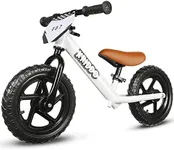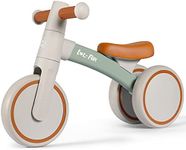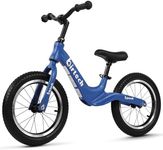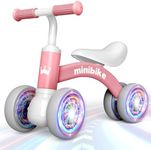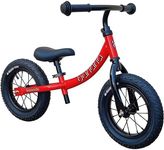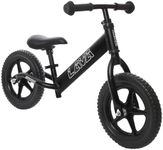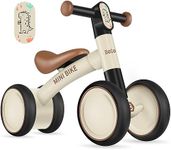Buying Guide for the Best Balance Bike
Choosing the right balance bike for your child is an important decision that can help them develop their balance and coordination skills. Balance bikes are designed to teach young children how to balance on two wheels without the need for training wheels. When selecting a balance bike, there are several key specifications to consider to ensure you pick the best fit for your child. Understanding these specs will help you make an informed decision and provide your child with a safe and enjoyable riding experience.Bike SizeThe size of the balance bike is crucial because it needs to fit your child properly for them to ride comfortably and safely. Bike size is typically determined by the wheel size, which ranges from 10 to 14 inches. For younger or smaller children (ages 18 months to 3 years), a 10-inch wheel size is usually appropriate. For older or taller children (ages 3 to 5 years), a 12-inch or 14-inch wheel size may be better. To ensure the right fit, your child should be able to sit on the seat with their feet flat on the ground and have a slight bend in their knees.
WeightThe weight of the balance bike is important because a lighter bike is easier for a young child to handle and maneuver. Balance bikes can range from as light as 4 pounds to over 10 pounds. For very young children or those who are just starting out, a lighter bike (around 4-6 pounds) is ideal as it will be easier for them to control. As your child grows and becomes more confident, they may be able to handle a slightly heavier bike. Always consider your child's strength and ability when choosing the weight of the bike.
Seat HeightThe seat height of a balance bike should be adjustable to accommodate your child's growth. The correct seat height allows your child to sit comfortably with their feet flat on the ground. Most balance bikes offer adjustable seat heights, typically ranging from 10 to 20 inches. When selecting a bike, ensure that the lowest seat height is appropriate for your child's current height, and that there is room for adjustment as they grow. This will ensure that the bike remains comfortable and usable for a longer period.
Frame MaterialBalance bike frames are commonly made from materials such as steel, aluminum, or wood. Each material has its own advantages. Steel frames are durable and sturdy but can be heavier. Aluminum frames are lightweight and resistant to rust, making them easier for young children to handle. Wooden frames are eco-friendly and have a classic look, but they may not be as durable as metal frames. Consider the weight, durability, and aesthetic preferences when choosing the frame material that best suits your child's needs.
TiresThe type of tires on a balance bike can affect the ride quality and terrain suitability. There are two main types of tires: air (pneumatic) tires and foam tires. Air tires provide better traction and a smoother ride, especially on uneven surfaces, but they require maintenance to keep them inflated. Foam tires are maintenance-free and puncture-proof, making them a good option for indoor or smooth outdoor surfaces. Consider where your child will be riding the bike most often and choose the tire type that best matches those conditions.
BrakesSome balance bikes come with hand brakes, while others do not. Hand brakes can be a useful feature for older children who are ready to learn how to use them, as it prepares them for transitioning to a pedal bike. However, very young children may not have the hand strength or coordination to use hand brakes effectively. If your child is just starting out, a balance bike without brakes may be sufficient. As they grow and develop their skills, you can consider upgrading to a bike with hand brakes.
